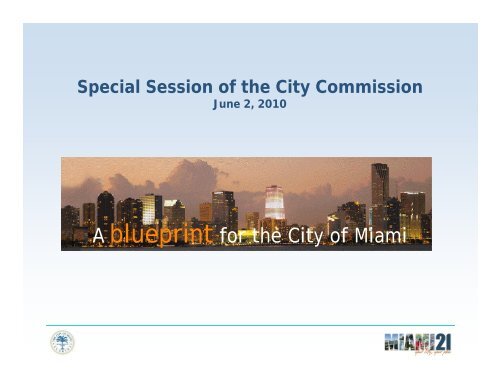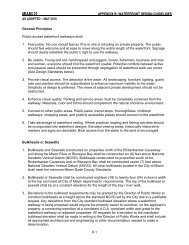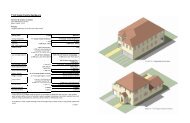Special Session of the City Commission - Miami 21
Special Session of the City Commission - Miami 21
Special Session of the City Commission - Miami 21
Create successful ePaper yourself
Turn your PDF publications into a flip-book with our unique Google optimized e-Paper software.
<strong>Special</strong> <strong>Session</strong> <strong>of</strong> <strong>the</strong> <strong>City</strong> <strong>Commission</strong><br />
June 2, 2010<br />
A blueprint for <strong>the</strong> <strong>City</strong> <strong>of</strong> <strong>Miami</strong>
Question<br />
Single Family and Duplex<br />
As requested, analysis is based on single story structure on 50 x 100 lot<br />
Are SF homes getting smaller?<br />
What is maximum size <strong>of</strong> <strong>the</strong><br />
structure under 11000 and <strong>Miami</strong><br />
<strong>21</strong>?<br />
What is minimum unpaved area<br />
under 11000 and <strong>Miami</strong> <strong>21</strong>?<br />
What documents required for<br />
approval to expand structure?<br />
Process to eliminate trees as part<br />
<strong>of</strong> expansion? Trees eliminated?<br />
Response<br />
No. For typical lots, front, side and rear setbacks<br />
are <strong>the</strong> same as <strong>the</strong> former code. Allowed lot<br />
coverage is <strong>the</strong> same on ground floor. As a benefit,<br />
porches can be more prominent under <strong>Miami</strong> <strong>21</strong><br />
Size <strong>of</strong> <strong>the</strong> structure is <strong>the</strong> same in both scenarios<br />
(2,500 square feet on a typical 5,000 sf lot)<br />
There are green space requirements<br />
11000: 15% <strong>of</strong> gross lot (937 sf on typical lot)<br />
M<strong>21</strong>: 25% <strong>of</strong> <strong>the</strong> lot area (1,250 sf on typical lot)<br />
Documents required through <strong>the</strong> building permit<br />
process as part <strong>of</strong> <strong>the</strong> work to be done. Plans,<br />
survey, etc. Not a <strong>Miami</strong> <strong>21</strong> requirement<br />
Process for tree removal as per Chapter 17 <strong>of</strong> <strong>City</strong><br />
Code for environmental preservation. Trees may be<br />
eliminated, replaced or relocated.
Single Family and Duplex<br />
As requested, analysis is based on single story structure on 50 x 100 lot<br />
Question<br />
What has changed in <strong>the</strong><br />
definition <strong>of</strong> residential floor<br />
area?<br />
How would this affect adjusted<br />
square footage reported to tax<br />
assessor?<br />
Will house appear bigger now?<br />
Will taxes go up as a result?<br />
What would make a house<br />
non-conforming?<br />
Response<br />
Buildable areas are based on lot coverage and setbacks.<br />
Floor Lot Ratio (FLR) is not used in <strong>the</strong> calculations for<br />
single family homes and duplexes.<br />
<strong>Miami</strong> <strong>21</strong> does not affect square footage used by Tax<br />
Assessor. Criteria for methodology used in assessment<br />
process is established by Florida Statutes.<br />
No. See above.<br />
Nonconformities are created any time zoning regulations<br />
are modified. As such, non-conformities regularly occur<br />
and are not limited to adoption <strong>of</strong> new codes, but have<br />
existed from amendments <strong>of</strong> city’s first zoning code<br />
(1934). Just means structures were built under<br />
requirements <strong>of</strong> different zoning regulations. Structures<br />
have and continue indefinitely as were built.
Single Family and Duplex<br />
As requested, analysis is based on single story structure on 50 x 100 lot<br />
Question<br />
Response<br />
Keep a non-conforming house<br />
forever? Will I be able to sell it?<br />
Will this be a material defect that<br />
need to be reporter by realtor?<br />
What happens to non-conforming<br />
house in 20 years?<br />
Do I need to do anything to keep<br />
my house?<br />
Yes.<br />
No, this is not a material defect. Structures can still be<br />
modified, enlarged, and altered with no percentage<br />
limitations by Waiver.<br />
Nothing.<br />
No modifications are required. Structure remains<br />
indefinitely.<br />
Can I convert attached garage to<br />
granny flat?<br />
What are <strong>the</strong> requirements to do<br />
so?<br />
If it exists illegally, what would be<br />
needed to legalize it?<br />
Nei<strong>the</strong>r 11000 nor <strong>Miami</strong> <strong>21</strong> allow <strong>the</strong> conversion <strong>of</strong><br />
attached garages to granny flats.<br />
This scenario was not allowed under 11000 and is not<br />
allowed under <strong>Miami</strong> <strong>21</strong>.<br />
No provisions exist to legalize a structure built outside<br />
what is allowed. This is different <strong>the</strong>n a structure that<br />
is allowed, but constructed without a permit.
Single Family and Duplex<br />
Question<br />
If I build a new home, what is <strong>the</strong><br />
difference between new house and<br />
o<strong>the</strong>rs in <strong>the</strong> block?<br />
Will I have to place parking on <strong>the</strong><br />
side <strong>of</strong> <strong>the</strong> house?<br />
Will <strong>the</strong>re be regulations to number<br />
<strong>of</strong> trees?<br />
Can I have a fence in <strong>the</strong> front <strong>of</strong><br />
<strong>the</strong> house? How high? How about<br />
around <strong>the</strong> property? How high?<br />
Could I have a circular driveway?<br />
Could I have a swimming pool and<br />
pool deck? Does it count against<br />
<strong>the</strong> minimum paved area?<br />
Response<br />
There are bound to be differences depending when<br />
o<strong>the</strong>r homes were built. Differences may be minor.<br />
Home built in <strong>the</strong> 80’s may have more prominent<br />
garage, whereas M<strong>21</strong> would require garage to be in<br />
line with main façade <strong>of</strong> home.<br />
One parking space has to be in line with main façade<br />
<strong>of</strong> home.<br />
Same as 11000, one tree on front setback per each<br />
fifty feet <strong>of</strong> frontage. New Construction requires three<br />
trees, same as 11000<br />
Yes, aluminum or iron picket and post fences are<br />
allowed up to five feet, all o<strong>the</strong>rs are allowed to 3 ½<br />
feet. Side and rear fences can go as high as 8 feet.<br />
Yes if <strong>the</strong>re is sufficient lot width to meet driveway<br />
separation requirements<br />
Yes. It is not considered green space. The same is<br />
true under 11000.
Single Family Issues<br />
McMansions<br />
Single Family<br />
ZO 11000 <strong>Miami</strong> <strong>21</strong><br />
Duplex
Commercial Properties<br />
Question<br />
Will commercial single<br />
story structures under<br />
<strong>Miami</strong> <strong>21</strong> be smaller in size<br />
than under 11000? If so<br />
how much?<br />
What is <strong>the</strong> minimum<br />
unpaved area that a<br />
commercial property can<br />
have under 11000? Under<br />
<strong>Miami</strong> <strong>21</strong>?<br />
Can a not-conforming<br />
commercial property be<br />
expanded?<br />
Response<br />
Will be able to accomplish <strong>the</strong> same or increased amount <strong>of</strong><br />
square footage. Maximum lot coverage was increased to<br />
allow buildings to provide liners along <strong>the</strong> ground level and<br />
still provide required parking.<br />
There is no minimum unpaved area. When comparing<br />
codes, both require 10% <strong>of</strong> gross lot and net lot,<br />
respectively. For commercial property, open space can be<br />
provided (paved/unpaved) in <strong>the</strong> form <strong>of</strong> expanded<br />
sidewalks, plazas, planting beds, etc.<br />
Yes, any non-conforming structure can be expanded without<br />
<strong>the</strong> need for a special permit if in compliance with <strong>Miami</strong> <strong>21</strong>.<br />
An expansion <strong>of</strong> <strong>the</strong> non-conforming portion <strong>of</strong> <strong>the</strong> structure<br />
may be done, but will require a special permit and is subject<br />
to limiting conditions. None<strong>the</strong>less, <strong>the</strong> regulations under<br />
<strong>Miami</strong> <strong>21</strong> are more flexible than 11000.
Nonconformities<br />
Single Family, Duplex, Multifamily<br />
Destruction in <strong>the</strong><br />
event <strong>of</strong> a disaster<br />
If 50% or more <strong>of</strong> assessed<br />
valuation<br />
If less than 50% <strong>of</strong> assessed<br />
valuation<br />
ZO 11000 <strong>Miami</strong> <strong>21</strong><br />
The home may not be rebuilt<br />
except by public hearing and<br />
special exception.<br />
Allows reconstruction <strong>of</strong><br />
house and does not<br />
stipulate percentage<br />
requirement regardless <strong>of</strong><br />
<strong>the</strong> amount <strong>of</strong> damage.<br />
Home may be restored if Application for reconstruction<br />
begun within six (6) months. must be filed within twelve<br />
This part <strong>of</strong> <strong>the</strong> code is (12) months from date <strong>of</strong><br />
unclear since it addresses <strong>the</strong> destruction. This time period<br />
use <strong>of</strong> a structure and not <strong>the</strong> may be fur<strong>the</strong>r extended by<br />
structure itself.<br />
<strong>the</strong> <strong>City</strong> <strong>Commission</strong>.<br />
Repairs and Maintenance <strong>of</strong><br />
property<br />
Only 20% <strong>of</strong> <strong>the</strong> gross square<br />
footage <strong>of</strong> <strong>the</strong> nonconforming<br />
home can be repaired within a<br />
twelve (12) month period.<br />
Allows nonconforming home to<br />
be maintained and repaired.<br />
Does not stipulate a<br />
percentage or time frame.
Destruction in <strong>the</strong><br />
event <strong>of</strong> a disaster<br />
Nonconformities<br />
O<strong>the</strong>r Structures<br />
ZO 11000 <strong>Miami</strong> <strong>21</strong><br />
If less than 50% <strong>of</strong><br />
Replacement or<br />
assessed valuation<br />
reconstruction is allowed by<br />
Class II (administrative) Replacement or<br />
within 6 months from date reconstruction is allowed by<br />
<strong>of</strong> destruction<br />
Waiver (administrative) within<br />
12 months from date <strong>of</strong><br />
If 50% or more <strong>of</strong> assessed May be allowed by <strong>Special</strong><br />
valuation<br />
Exception provided that<br />
destruction and does not<br />
reconstruction is essential to stipulate a percentage<br />
<strong>the</strong> reasonable conforming<br />
requirement<br />
use within 6 months from<br />
date <strong>of</strong> destruction<br />
* dd ll<br />
* In addition, allows <strong>City</strong><br />
<strong>Commission</strong> to authorize a<br />
time extension citywide
Nonconformities<br />
Uses<br />
Destruction in <strong>the</strong><br />
event <strong>of</strong> a disaster<br />
Less than or equal to<br />
50% <strong>of</strong> assessed value<br />
More than 50% <strong>of</strong><br />
assessed value<br />
ZO 11000 <strong>Miami</strong> <strong>21</strong><br />
Replacement or<br />
reconstruction is allowed<br />
by Class II<br />
(administrative) within<br />
6 months from date <strong>of</strong><br />
destruction<br />
May be allowed by<br />
<strong>Special</strong> Exception<br />
provided that<br />
reconstruction is<br />
essential to <strong>the</strong><br />
reasonable conforming<br />
use within 6 months<br />
from date <strong>of</strong> destruction<br />
Use may be restored by<br />
Warrant (administrative).<br />
Application for restoration<br />
shall be filed within<br />
twelve months <strong>of</strong><br />
destruction and does not<br />
stipulate a percentage<br />
requirement
Nonconformities<br />
General<br />
Alterations or<br />
expansions not<br />
affecting<br />
nonconformity<br />
Alterations or<br />
expansions <strong>of</strong> <strong>the</strong><br />
nonconformity<br />
Repair/<br />
Maintenance<br />
Single Family<br />
Duplex<br />
Multi-Family<br />
Building Permit Waiver Allowed, no<br />
percentage<br />
limitation<br />
All o<strong>the</strong>r Building Permit If < 50% Exception Allowed, no<br />
structures If ≥ 50% Not allowed percentage<br />
limitation<br />
Nonconforming<br />
Uses<br />
Building Permit as<br />
long as degree <strong>of</strong><br />
nonconformity is<br />
not increased<br />
If < 50% Exception<br />
If ≥ 50% Not allowed<br />
Allowed, no<br />
percentage<br />
limitation<br />
This scenario is more flexible than ZO 11000 since it distinguishes expansions that do not<br />
affect <strong>the</strong> nonconformity and also does not limit it <strong>the</strong> repair and maintenance that t can be done
Single Family
Commercial / Industrial<br />
Nonconformity Example
Commercial Examples
Fast Food or Bank<br />
Grocery Store<br />
& Bank<br />
Pharmacy or Convenience Store
Affordable Housing & M<strong>21</strong><br />
• <strong>Miami</strong> <strong>21</strong> takes a new approach to Affordable Housing <strong>of</strong>fering<br />
incentive based approach in all T6 areas <strong>of</strong> <strong>the</strong> city. The Public<br />
Benefits program encourages affordable housing in all<br />
neighborhoods by providing an onsite bonus and creates a trust<br />
fund to provide incentives for affordable housing<br />
• Intent is to include affordable housing in areas that are viable<br />
and attractive instead <strong>of</strong> placing <strong>the</strong>m in industrial or<br />
commercial areas where o<strong>the</strong>r neighborhood services and jobs<br />
may not exist. This is one <strong>of</strong> <strong>the</strong> many factors that ultimately<br />
create a diverse, attractive, stable and well served community<br />
• Public benefits program allows market-rate development to pay<br />
into <strong>the</strong> Trust Fund for additional capacity, which will expand<br />
<strong>the</strong> funds available for affordable housing
Affordable Housing<br />
Question<br />
<strong>Miami</strong> <strong>21</strong> has taken all C-2<br />
properties and re-zoned <strong>the</strong>m<br />
to ei<strong>the</strong>r T6-8, T6-12, or D-1.<br />
Affordable housing developers<br />
are competing with market<br />
rate developers for <strong>the</strong> same<br />
class <strong>of</strong> properties – properties<br />
are <strong>the</strong>n too expensive for<br />
affordable housing developers<br />
to use<br />
Response<br />
C-2 properties where housing was appropriate were zoned T5<br />
or T6 accordingly. Housing on C-2 was not allowed by right.<br />
Residential uses on T5 or T6 now allowed as <strong>of</strong> right, making<br />
process easier (and less expensive) for developers to include<br />
residential uses. Will ease approval process and facilitate<br />
receipt <strong>of</strong> State and Federal Housing incentives since does<br />
NOT require a public hearing to receive a development order<br />
Under M<strong>21</strong>, more land is available for residential development<br />
as <strong>of</strong> right. Market demands and location will determine land<br />
values. This holds true for any zoning classification, under<br />
11000 and M<strong>21</strong>. C-1 and C-2 2had similar il development<br />
capacities, <strong>the</strong>refore market conditions such as location, are<br />
more likely to have a determining factor on <strong>the</strong> value<br />
The Public Benefits program gives an advantage and<br />
incentive that allows additional capacity by providing<br />
affordable housing, an advantage that no one else has.<br />
T5 abutting a D1 can build an additional story and T6-8<br />
can receive 30% additional capacity, which gives<br />
affordable housing a competitive advantage
Affordable Housing<br />
Question<br />
D1 properties are zoned for<br />
Industrial and only allow<br />
live-work at 18 units/acre<br />
Response<br />
<strong>City</strong> <strong>Commission</strong> recently approved Work/Live Density to 36<br />
units per acre. However, <strong>the</strong>se zones are intended for <strong>the</strong> worklive<br />
environment as a way to create and maintain jobs within <strong>the</strong><br />
<strong>City</strong>.<br />
D1 is far too low a density<br />
C-2 zoning did not allow housing to occur as <strong>of</strong> right. It required<br />
for <strong>Miami</strong>’s affordable a <strong>Special</strong> Exception. Therefore <strong>the</strong>re was no guarantee that<br />
housing developers who housing could in fact be built in <strong>the</strong>se areas. In C-2 areas where<br />
were permitted 150 housing was not appropriate, <strong>the</strong> <strong>City</strong> could deny those<br />
units/acre under C-2<br />
zoning (and typically built<br />
in <strong>the</strong> 115-130 units/acre<br />
range)<br />
Exceptions. The D1, T5, and T6 allow for housing to be built as<br />
<strong>of</strong> right. It essentially determines where housing is appropriate.<br />
Affordable housing development should be occurring in areas<br />
that provide diversified housing opportunities. This maximizes<br />
<strong>the</strong> availability <strong>of</strong> different housing types, where communities can<br />
expand <strong>the</strong> supply <strong>of</strong> affordable housing and meet a wider range<br />
<strong>of</strong> <strong>the</strong>ir constituent’s needs.
Illuminated Signs<br />
Concern over illuminated signs within 100 feet from<br />
residential areas<br />
Change not recommended since it would make signage along<br />
– Change not recommended since it would make signage along<br />
many commercial corridors illegal as <strong>the</strong> examples below
Green Requirements<br />
• Over 30 municipalities now require LEED certification<br />
for private development, including Los Angeles,<br />
Boston, Tampa, Portland, and Washington, D.C.<br />
• Expedited permitting already exists as part <strong>of</strong> <strong>City</strong><br />
Code<br />
• Incentives exist for Gold and Platinum and also for<br />
properties below 50,000 square feet<br />
• Fees collected assist <strong>the</strong> Public Benefits Trust Fund<br />
• Enforcement <strong>of</strong> <strong>the</strong> regulations may not be feasible<br />
without some sort <strong>of</strong> verification process
<strong>City</strong><br />
Applicable to:<br />
Min. Cert.<br />
Level<br />
Size<br />
Threshold<br />
Required<br />
Documentation<br />
Enforcement<br />
Mechanism<br />
Payment/Fee/Bond<br />
Required<br />
Misc. Notes<br />
<strong>Miami</strong><br />
All New Constuction<br />
ti LEED Silver<br />
> 50K <strong>of</strong> habitable or<br />
space equivalent<br />
> 50K sf<br />
Performance bond<br />
shall hllbe issued<br />
prior to C.O. if<br />
certification not<br />
achieved<br />
50 ‐100K sf ‐ 2% <strong>of</strong><br />
Constr. Cost; 100K‐<br />
200K sf ‐ 3% Constr.<br />
Cost; > 200K sf ‐ 4% <strong>of</strong><br />
Constr. Cost<br />
<strong>City</strong> draws down<br />
on bond 1 year<br />
from issuance <strong>of</strong><br />
C.O.<br />
Washington, D.C.<br />
Non‐residential new<br />
construction and<br />
improvements over<br />
50K sf <strong>of</strong> gross Floor<br />
Area<br />
Meet or<br />
exceed<br />
LEED NC<br />
2.0/CS 2.2<br />
Certificatio<br />
n<br />
> 50K sf<br />
Agent or 3rd Party<br />
Agency shall review<br />
applications for<br />
compliance<br />
Performance bond<br />
or irrevocable<br />
letter <strong>of</strong> credit<br />
shall be issued<br />
prior to CO C.O.<br />
250K sf ‐ 4% <strong>of</strong> cost;<br />
not to exceed $3<br />
Million<br />
Addition <strong>of</strong><br />
'Green Building<br />
Fee' to<br />
construction<br />
permit fees;<br />
Exemptions<br />
granted by Mayor<br />
Los Angeles<br />
San Francisco<br />
All new Construction<br />
greater than 50K sf<br />
LEED<br />
Certified or >50K sf<br />
higher<br />
Resid: LEED<br />
Silver or<br />
High‐rise residential >50<br />
bldgs; Large Greenpoint<br />
Commercial buildings s; Comm:<br />
LEED Gold<br />
(by 2012)<br />
> 25K sf<br />
Submit LEED<br />
Scorecard and<br />
Signed declaration<br />
<strong>of</strong> compliance by<br />
LEED AP<br />
Withholding Bldg<br />
Permit<br />
At time <strong>of</strong> permit:<br />
Witholding <strong>of</strong> final<br />
Submit<br />
C.O. til acceptable<br />
documentation<br />
verification is<br />
from Pr<strong>of</strong>essional <strong>of</strong><br />
received; Failure<br />
Record that reqs<br />
shall be subject to<br />
have been met; At<br />
<strong>the</strong> procedures<br />
Completion: Final<br />
governing<br />
Certificate <strong>of</strong><br />
abatement <strong>of</strong><br />
Compliance verified<br />
unsafe structures<br />
by department<br />
Cost <strong>of</strong> Certifciation<br />
Cost <strong>of</strong> Certifciation<br />
Addt'l req. for<br />
small and midsize<br />
res and<br />
comm bldgs;<br />
Exemptions<br />
granted by<br />
Director
<strong>City</strong><br />
Applicable to:<br />
Min. Cert.<br />
Level<br />
Size<br />
Threshold<br />
Required<br />
Documentation<br />
Enforcement<br />
Mechanism<br />
Payment/Fee/Bond<br />
Required<br />
Misc. Notes<br />
Portland (proposed)<br />
Phased<br />
New Commercial and<br />
over time; ><br />
LEED Silver<br />
Multifamily buildings<br />
20K sf by<br />
2013<br />
LEED Certificaiton,<br />
verificaiton <strong>of</strong><br />
performance<br />
Feebate System<br />
Waiver <strong>of</strong> fee if min. cert.<br />
is acquired; fee assessed if<br />
under, reward provided if<br />
over<br />
Has not been<br />
approved<br />
Baltimore<br />
Newly constructed<br />
commercial or residential<br />
buildings<br />
LEED Silver<br />
10,000 s.f.<br />
or greater<br />
Pro<strong>of</strong> <strong>of</strong> certification <strong>of</strong><br />
LEED<br />
Witholding <strong>of</strong> building<br />
permit if no<br />
compliance<br />
Cost <strong>of</strong> Certifciation<br />
San Jose, CA<br />
Commercial/ Industrial<br />
and hi‐rise i residential<br />
private development<br />
Commercial:<br />
LEED (Silver or<br />
better)<br />
Residential:<br />
Build It<br />
Green's (BIG)<br />
Green Point<br />
Rated rating<br />
system<br />
25,000 S.F. Pro<strong>of</strong> <strong>of</strong> certification <strong>of</strong><br />
or greater LEED<br />
Payment <strong>of</strong> Green Building<br />
Refundable Deposit in<br />
amount set by resolution<br />
<strong>of</strong> city council prior to <strong>the</strong><br />
issuing <strong>of</strong> a building permit<br />
Cincinnatti<br />
Newly constructed or<br />
rehabilitation <strong>of</strong><br />
commmerical or<br />
residential properties<br />
LEED certified<br />
N/A<br />
Pro<strong>of</strong> <strong>of</strong> LEED<br />
Certification<br />
properties will be<br />
monitored for<br />
violation <strong>of</strong> contract in<br />
which case abatement<br />
can be rescinded or<br />
terminated<br />
Abatement 15 years for<br />
new construction and 12<br />
years for renovation<br />
Chatham County, GA<br />
All Commercial buildings.<br />
(Qualifying projects are<br />
new or expanding<br />
businesses in an<br />
enterprise zone that<br />
increase employment<br />
opportunities)<br />
LEED Gold<br />
Certification<br />
Full property state and<br />
county tax abatement for<br />
<strong>the</strong> first five years, <strong>the</strong>n<br />
tapering <strong>of</strong>f by 20% each<br />
year until <strong>the</strong> tenth year.
Possible Alternatives<br />
• LEED Checklist in lieu <strong>of</strong> bond<br />
requirement; withhold Certificate <strong>of</strong><br />
Occupancy (CO)<br />
• Fine for failure to comply<br />
• Alternative ti financial i instruments t in lieu <strong>of</strong><br />
bond









